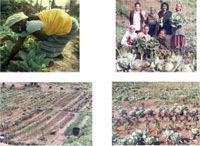7.5.5 Dietary diversification and modification for Vitamin A
As well as the strategies you read about in 7.5.1, there are longer-term and more sustainable interventions for the prevention of vitamin A deficiency. As a Health Extension Practitioner, you are expected to encourage family members to grow and consume vitamin A rich foods at all times. This requires input from several of your colleagues, such as the development agents, teachers, local administration and local NGOs. You can initiate and coordinate the establishment of horticultural demonstration gardens in health post and schools, as well as agricultural extension demonstration plots in farming areas. These horticultural gardens can also serve as examples for dissemination of information on the use of fruits and vegetables, and the distribution of seedlings that could be grown around rural homes. Health Extension Practitioners can therefore play a significant role in promoting the introduction of vitamin A rich foods and improving consumption and storage of such foods. Box 7.2, describes foods that are good sources of vitamin A and in Figure 7.5 you can see photos taken during a visit to a women’s project where food is being produced for their village.
Box 7.2 Examples of food sources rich in vitamin A.
Animal sources of Vitamin A
- The best food sources are animal foods such as egg yolks, organ meats such as liver, whole milk and milk products, small fish with the liver intact, fish, cod liver oil, butter, and ghee.
- The best source of vitamin A for infants is breastmilk. The mother’s secretion of vitamin A into breastmilk is related to her own vitamin A status.
Plant Sources of Vitamin A
- The best plant sources of vitamin A are dark orange or dark yellow fruits and vegetables such as papayas, mangos, pumpkins, carrots, and yellow or orange sweet potatoes, and dark green vegetables such as spinach and kale
- ‘Gommen’ is an example of a traditional plant which is rich in vitamin A and commonly included in the Ethiopian diet.
Food fortification
This involves adding one or more vitamins and minerals to commonly consumed foods, especially those for children, with the purpose of preventing or correcting a demonstrated deficiency. It is difficult to fortify foods in Ethiopia because no staple food has been identified as widely consumed in the entire country. However, efforts are underway to fortify oils that are being produced in some of the larger factories.
7.5.4 Choking after a vitamin A dose

